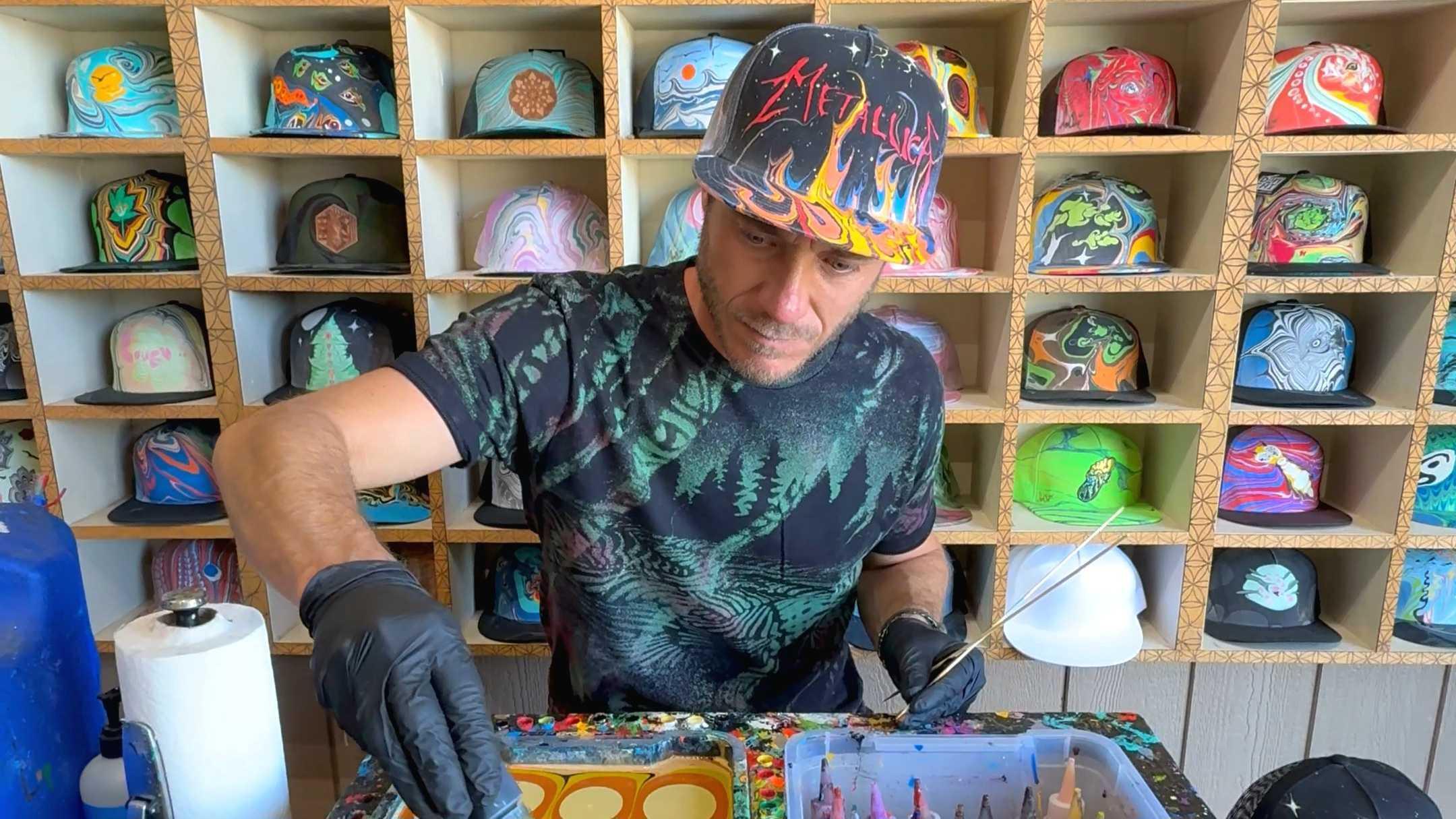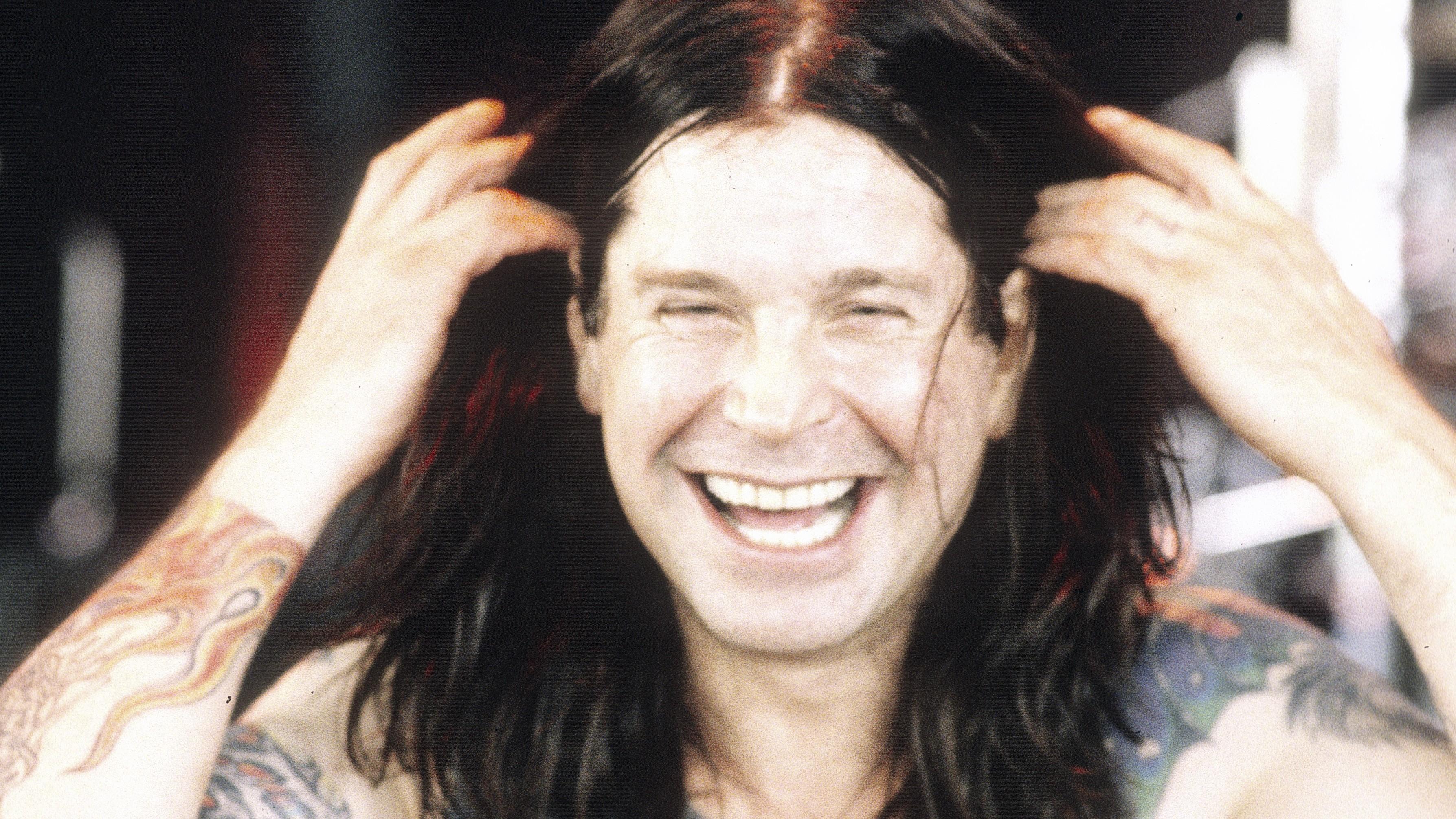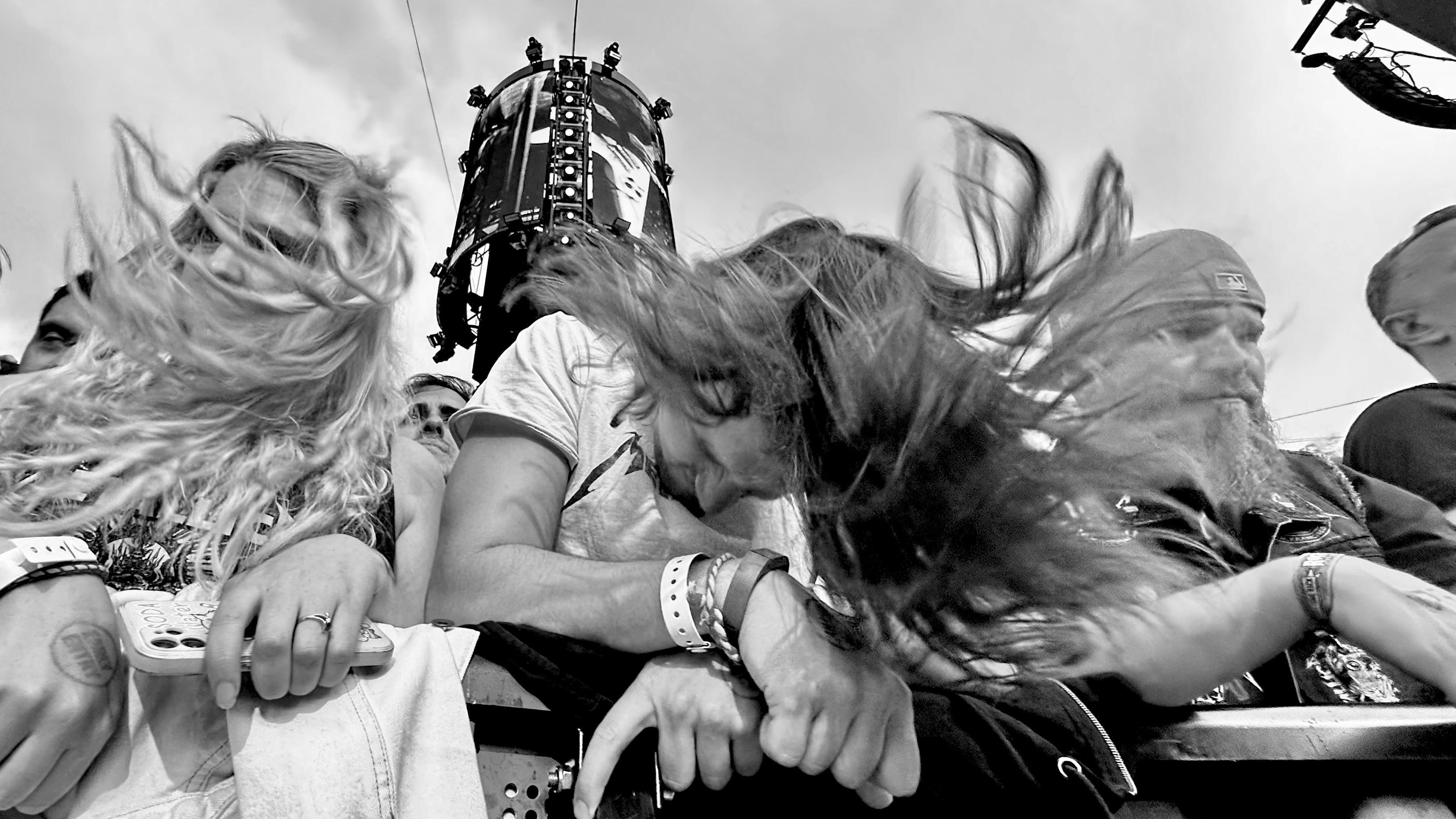
Renaissance Man
Dominic Padua (aka Dom Chi) does many things very well, including the art of marbling. Steffan Chirazi visits his Sebastopol, CA, studio to learn more.
Jul 30, 2018
When it comes to selling merch on the European road, Andrew Scott has forgotten more than you’ll ever know.
BY STEFFAN CHIRAZI
VIDEO BY BRETT MURRAYAndrew Scott – or Scotty as he is known on the WorldWired Tour – is the band’s head of tour merchandise in Europe, working for the band’s European merchandiser, Probity. A seasoned veteran of the road, Scotty was born in Barbados before moving to Harlesden in London. He ended up in Islington, North London where he worked in Covent Garden’s Blitz nightclub (where Steve Strange was helping found the New Romantic genre) before finding himself falling into a road job selling merchandise in 1980. Scotty has not looked back and has worked with some tremendous acts and events including Stevie Wonder, Rush, Marvin Gaye, Paul McCartney, George Benson, Live Aid 1985 and, err, Metallica. Oh, did I mention Bob Marley? Yes, that’s right, Andrew Scott is cool for sure, and aside from all that, he is a thoroughly nice and decent man, the sort of guy that every tour needs. Because whilst Scotty is all of that and more, he also does not suffer fools, although even that you suspect is done with more respect and manners than most. I also got the impression that Scotty is certainly not one to tell you everything about everything, remaining discreet whilst simultaneously polite and friendly – a rare skill-set combination indeed. Our conversation took place in the back of a massive semi-truck which ferries the merch from city to city.
Steffan Chirazi: Has anyone ever tried to sneak in here and steal stuff?
Andrew Scott: Not in the back of a truck, no. It’s usually happened on the stands or something like that.
SC: Oh, really? That’s happened? People make a run on the stand(s)?
AS: Oh, yeah, it’s happened before, yeah.
SC: Not on this tour.
AS: Not on this tour, no. Actually, the kids [on this tour], although they’re loud and boisterous, they’re always gentlemen.
SC: Good to hear…okay, tell us how did you got into this line of work?
AS: Oh, purely by accident. A friend of mine said, “Do you fancy coming abroad?” I said yeah, and that was it. That was with Barclay James Harvest in 1980.
SC: So fresh out of school?
AS: Not so much fresh out of school, but fresh. Fresh into Europe; it was my first time into Europe.
SC: It was a very different climate back then, so how would you prepare for a day of merch on tour back at that time?
AS: Back at that time, you’d just turn up at the venue. There were no concessions. You’d just turn up at a venue, find your spot, and just start setting up around about 3:00 in the afternoon.
SC: And were you the person, did you have to make deals with the promoter?
AS: Yes. Always, yes. I have to do all that [today too – ED]. They decide how much they’re gonna charge you, where you go, how much room you can have, and all that really.
SC: Was it easier back then?
AS: It was easier, yes, because now... It was just fun back in those days. It really was fun. It was just “off-the-head” as well because merch wasn’t really well known then. But as time went on people realized how much money was involved in it and yeah, then accountants got involved and it [tightened up].
SC: So how many shirts were you selling on the BJH tour for example, and how many different designs were there on that tour in particular?
AS: Oh, it was probably four or five different designs. No more than that. And a sweatshirt plus a poster. Posters used to sell really big in those days.
SC: And tour books?
AS: Tour books? Yeah, but it’s really funny about tour books, [they] only really sell a lot in England. Europe? They hardly ever sell that many. It’s always been that way.
SC: So you’ve watched it growing over the years, you watch things change. What’s changed with what you have to deal with?
AS: With us guys, it’s not so much. You used to just go there, set up, do your paperwork, report to the office, and that’s it.
SC: Long-hand of course, on a jotter with a pen!
AS: And also have loads of coins, try and find a phone box to phone home. But now it’s all computerized. You have to send reports every night to management, the [merchandise company] office, and certain people. So yeah, it’s a lot of paperwork now, which really does get on my nerves.
SC: But it’s interesting, you say it’s computerized. And I mean you know, I guess because albums aren’t selling the way they used to, merchandise is kind of the new cash stream.
AS: It is. Very much so.
SC: So talk about how it’s affected what you have to deal with in terms of the volume of product, and also how the fact that albums aren’t selling as strongly impacts your world.
AS: Well, a lot of bands now, what they do – because as you said albums are not selling that much in shops – they tend to try to sell them [their albums and CDs – ED] on the merchandise stand. And they do sell a lot more on the merchandise stand because people hear it and then it’s fresh in their minds and they want to buy it, listen to what they’ve just heard. So you do sell a lot of albums and CDs – and also vinyls are making a big comeback.
SC: Are people buying more band merch on tour these days? What was the average “spend per head” back in the early ’80s versus the average per head now if you’re talking about a comparable heavy metal band? Let’s say Iron Maiden?
AS: Iron Maiden. Okay, back in the day, they’d probably do, say, four or five pounds a head, compared to now you’re talking about ten to fifteen. But you have to look at the prices. The prices are a big difference now to what they were back in the day.
SC: Do you mean a larger margin than they used to be?
AS: Larger margin, yes.
SC: And that’s because people, I guess, can afford it regardless?
AS: The cost of manufacturing the shirts has risen, the cost of the print and all that, so all that’s taken into consideration.
SC: On this tour, what are the two biggest, most consistent sellers?
AS: The biggest is the album shirt. Still. Amazing, because it’s been online for nearly two years now, and every night it’s still the best seller. And there’s one shirt we sell which totally happened by accident. We designed it from the first gig in Copenhagen, the arena, and we actually printed a bit too many, so we overprinted the back and sold it at another show. That is still the second-best selling shirt. And it’s still the same arena in Copenhagen. It’s a good shirt. It’s a good design.
SC: Do you ever talk to the kids? Do you ever spot a kid and say, “Hey, can I talk to you for five minutes about what you’re seeing?”
AS: All the time. I speak to the kids a lot. If I see them wearing a shirt I don’t recognize I’ll ask them where they got it from. And I’ve seen so many different Metallica shirts. Honestly, you wouldn’t believe, there’s so many different ones. There’s lots of bootlegs, obviously, but lots of official shirts because the band also sell a very big range online. So you see them come to the gigs and some are very interesting.
SC: What’s the lag time between something from tour getting into a store?
AS: The stuff we sell on the road doesn’t go into retail until the whole tour is finished, and it only goes into retail if there’s any left. But basically, we do a totally different line for retail, because retail now has become very fashionable [with] stuff that you couldn’t sell to Metallica fans on the road because they wouldn’t buy it.
SC: So you’re talking about the more designer t-shirts and so on and so forth.
AS: Yeah, for the girls and all that, yeah.
SC: Because there is a change in the fan base, a lot more kids, a lot more girls. Are you seeing new stuff popping up in your range?
AS: No, no, but what we’re seeing is we’re selling a lot more smalls. And that tells us that there’s a younger audience and [Metallica is] attracting younger fans as well. And also more girls because they tend to buy the men’s small rather than the ladies shirt sometimes.
SC: I have to ask (given that you’re dealing with a lot of numbers), as a kid did you have a mathematical brain?
AS: I was always good at numbers at school, I enjoyed them as well.
SC: So it’s an enjoyable thing to sit and crunch numbers?
AS: Oh, it is, yeah. Now most of my time is spent at the computer. But back in the day it used to be a calculator and a pen and paper.
SC: And how do inventories go? You hear about trucks with GPS devices and all that business so as they can monitor where they’re going and so on and so forth. How do you account for these boxes? What’s the system these days? It’s not like five bar gates on a piece of paper anymore.
AS: As far as stock, everything is set up and formalized on the computer now. Every night we do a count-in and a count-out, and I have my starting numbers in my computer. And it tells me what, exactly, I have left in the truck.
SC: How is the WorldWired crowd looking these days? What are the biggest selling sizes?
AS: It’s a lot of double-Xs, especially in certain countries like Germany and some parts of Scandinavia. In Spain and Italy, it’s a lot smalls and mediums. We base how we order stuff for certain countries on that information as well.
SC: Let’s talk about how South America has changed in the last decade (as a market).
AS: South America used to get bootlegged really, really heavily, and sometimes it wasn’t worth going there. But now it’s changed where you still get bootlegs, but the audience have actually realized what official stuff is, so they tend to buy more official stuff than bootleg now. Even if it’s there. And South America’s a good market now. It wasn’t before.
SC: What made that change in your opinion?
AS: I think it’s probably the internet that has made that change, so they’re much more aware of official merchandising.
SC: Interesting stuff. Okay, give us some of the early, fun career memories.
AS: Early memories… Okay, I’ll give you one. Bob Marley. 1980. I did his last ever tour in Europe.
SC: Well, you need to carry on now!
AS: It was amazing, an amazing tour. I was young, keen, on an amazing tour, and every night there was never a set list. Every night was a different set, and it was purely from just what they felt like onstage.
SC: Wow.
AS: That was an amazing experience.
SC: How many shirts did Bob Marley have out?
AS: Three or four shirts, that’s it.
SC: And please tell me that you still have a couple.
AS: I don’t, I gave them away, I gave ’em all away. That’s what I used to do. I used to come home, fill a bin bag full of all the shirts I had, and take ’em to charity shops.
SC: That’s top man, great. Did you interact with Marley? Did you talk with him?
AS: I didn’t. I traveled in the bus once with him.
SC: How was that?
AS: That was very… “stoney,” put it that way!!!
SC: You’re saying it was hard to see him through the cloud of smoke?
AS: Yes, yes, yes.
SC: But mellow?
AS: Very mellow.
SC: And were you working directly with him or did he have a merchandise deal?
AS: It was with a company called Concert Publishing who were one of the first merchandise companies. They were based in England, and we used to do every band there was. You name it, we used to do it. But then Winterland [a large US-based merchandiser of the time – ED] came in and they started offering the bands a lot of big advances, and that’s when merchandising changed. I started with Concert Publishing, then I left and went to work for a company called Giant. And then we, as a merchandising company, evolved from there into what we are now: Probity. It is the same group of people.
SC: And it must be a reputation thing in this business. I would suggest that honor and integrity are big parts of doing merch on tour. Because there’s probably a lot out there who’ve done one tour and out, am I right?
AS: Yes, there are. But we get bands because I think they trust us, and we work with the same bands. I mean, my boss Mark Stredwick, he’s very, very good with management. He’s very good at turning stuff around and getting whatever the band wants. He’ll do it, no matter what.
SC: Very good. So a couple of other stories? I mean although in fairness, it’s gonna be tough to top Bob Marley.
AS: There’s some I can’t tell.
Brett Murray: You have some previous experience with a member of Metallica.
AS: Yes, I do. Mr. Robert [Trujillo]. When I worked for Suicidal Tendencies. It was good fun, one of the good tours as well, yeah. He was very quiet and very courteous, but he did leave me behind once.
SC: What? Where?
AS: It was in France somewhere. I was traveling on the bus with them. I came down, and I forgot something in my room and I said to Robert, “Rob, I’m just going up to my room.” I come down, the bus had gone. I had to get the train and meet up with them in Barcelona! I said to Rob, “What happened?” And he said, “You told the wrong person!!!” And that was that, yeah. I should have told the bus driver.
SC: What’s the worst set of circumstances you’ve run into, and what would be the worst now?
AS: The worst then was trying to leave France, we had all the cash on us and we got caught. So we couldn’t leave the country. We had to sort of “find a way of banking it,” yeah. The worst thing now would be if you’re low on stock and it’s a bank holiday. That’s probably the worst scenario. But that doesn’t happen now because we plan ahead; we always plan at least a week ahead.

Dominic Padua (aka Dom Chi) does many things very well, including the art of marbling. Steffan Chirazi visits his Sebastopol, CA, studio to learn more.

What you are diving into here is my personal journal with regards to the Back to the Beginning extravaganza. Much of it was written off-the-cuff, and the sheer magnitude of the event means that even now there are still pieces of “thought” swirling in the ether and making brain fall by the hour. These recollections, emotions, and observations are shared reflectively over three separate entries after the event and are split between an initial “post-event download” and then a more chronological reflection on our time in Birmingham…
